India’s wine country is a charming work in progress
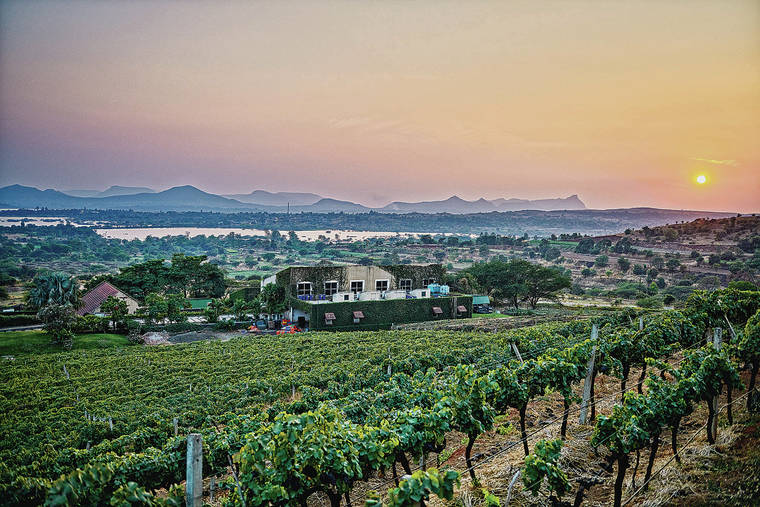
NEW YORK TIMES
An overview of Grover Zampa Vineyards in Nashik, India. Visitors to the Nashik region are rewarded with winemaker-led tastings, 2,000-year-old cave carvings and a few bottles of delicious wine.
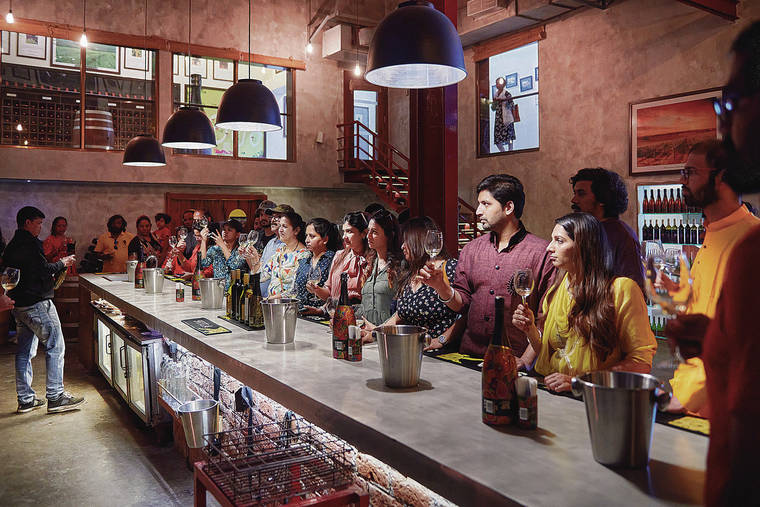
NEW YORK TIMES
A group of visitors during a wine tasting at Sula Vineyards, India’s biggest winemaker, in Nashik, India.
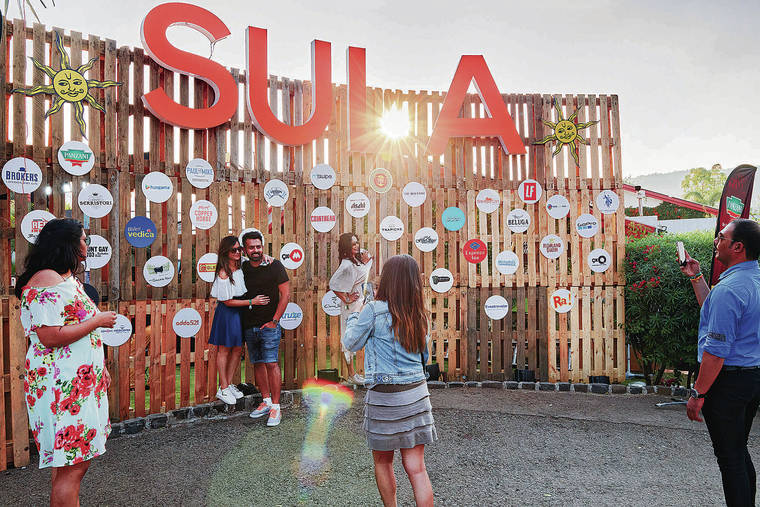
NEW YORK TIMES
Visitors stop for photos at Sula Vineyards, India’s biggest winemaker, in Nashik, India.
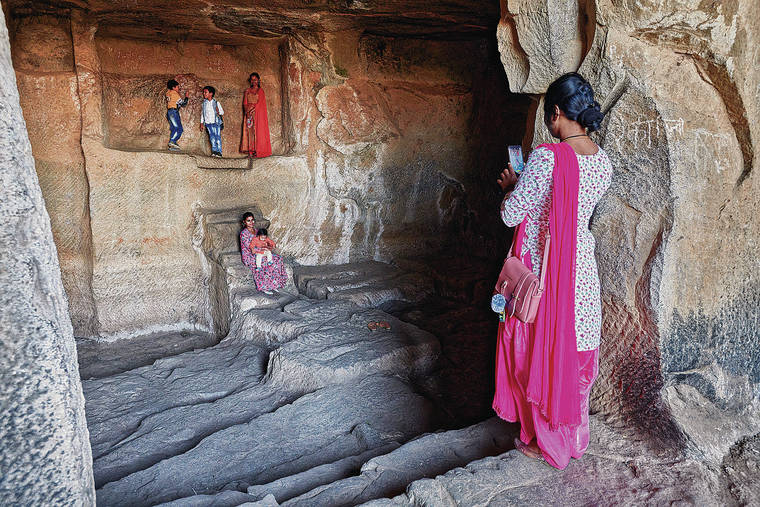
NEW YORK TIMES
Tourists at the Pandavleni caves, which feature ancient Buddhist carvings, some more than 2,000 years old, in Nashik, India.
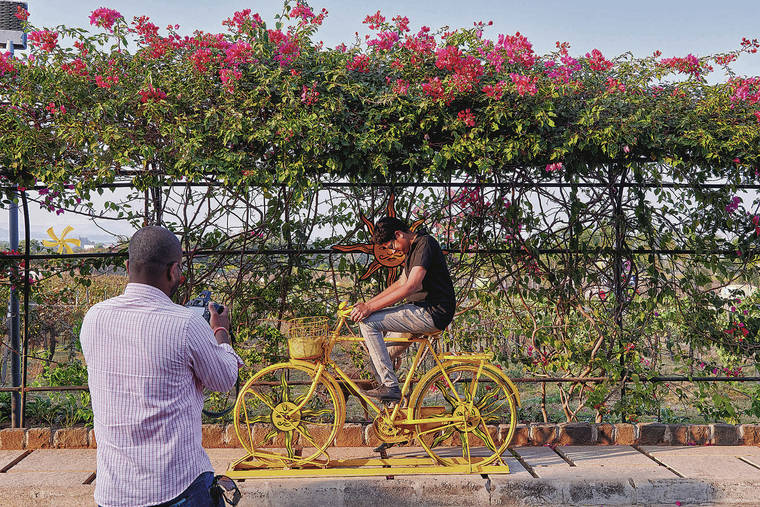
NEW YORK TIMES
Visitors stop for photos at Sula Vineyards, India’s biggest winemaker, in Nashik, India.





After a bumpy ride on broken, barely paved roads through Nashik’s dusty farm country, my family finally arrived at Grover Zampa Vineyards.
At least that’s what Google Maps told us.
One of India’s oldest and best wineries looked more like a construction site that had been abandoned midproject: An open-sided building was surrounded by concrete slabs, poles and lumber.
My wife spotted a pair of 6-foot-tall wine bottles and stacks of empty boxes — promising signs of an active winery — but there were no people other than a security guard.
Finally, Sushant Soni, Grover’s hospitality manager, appeared. He apologized for the delay and for the mess. The building in the center was destined to be a new restaurant, he said, and the winery was renovating everything, including the tasting room. For now, though, tastings were being held in a conference room — don’t trip over the beams on the ground, please!
Like India’s wines themselves, the tourist experience in the country’s winemaking capital is a work in progress. No one would mistake Nashik for California’s Napa Valley, with its Michelin-starred restaurants and pricey mud baths. Nor is it anything like Italy’s Tuscany, where medieval towns, farmhouse inns and family wineries are scattered across the region. Yet Nashik’s lack of a tourist-industrial complex is part of its charm. During our three-day excursion, we tasted wines with the people who made them, explored caves full of ancient Buddhist carvings and ate a lovely lunch while gazing across grapevines to a sun-dappled lake. We even found some delightful wines.
Don't miss out on what's happening!
Stay in touch with breaking news, as it happens, conveniently in your email inbox. It's FREE!
Another bonus: There were hardly any other tourists. Even among Indians, the Nashik area is best known for its onions and table grapes, farmer activism and temples, including Trimbakeshwar, where a major Hindu festival, the Kumbh Mela, is held once every 12 years.
Nobody even produces a decent map of the Nashik’s three dozen wineries, forcing visitors to rely on word of mouth or well-phrased Google searches. The tourism body of Maharashtra, the state where Nashik is located, is so apathetic that it erroneously refers to the wineries as “breweries” in a brief mention on its website. The biggest hotel in the area, the Gateway, is owned by the luxury Taj chain but has all the charm of a roadside Holiday Inn.
“India is very good at hospitality,” said Sonal Holland, a Mumbai wine entrepreneur and educator who runs India’s premier tasting event, the India Wine Awards. “It’s a real shame that the industry has failed to take advantage of this massive opportunity that wine tourism can unlock.”
My wife and I had been itching to check out Nashik ever since we moved to Mumbai from the San Francisco Bay Area in 2017. We both love wine, and it has been a part of some of the most important moments in our lives: I proposed to her during a birthday trip to Napa, and we were married at a winery in Brooklyn, New York.
After a three-hour drive from Mumbai, we began, appropriately, at The Source, a hotel run by Sula Vineyards. Sula, India’s biggest winemaker, has done more than any other organization to promote Indian wine and the wine-tasting experience. In addition to The Source, it operates another hotel nearby, hosts a music festival every February and exports its wines widely.
Our preschooler was famished, so we headed to the property’s Italian restaurant, where the attentive waitstaff helped us match Sula’s wines with minestrone soup, insalata mista, pizza and spaghetti aglio e olio. The food was fine, but the wines were disappointing. We found the chardonnays, both still and sparkling, to be thin, with no finish. And the zinfandel had none of the rich jammy notes you typically find in even the cheapest California zins.
Taking the winery tour, which excluded the actual grapevines growing outside, we heard how Sula’s founder, Rajeev Samant, had returned to the family farm from a stint at Stanford and Oracle in Silicon Valley in the 1990s and decided to make wine.
Today, Sula sells 34 wines from 14 grape varietals, thriving despite the immense challenges of running a profitable wine business in India. Although the high taxes on imports give Indian producers a leg up, the wines must also survive long truck rides in the country’s searing heat, warehouses without proper climate control, and retailers that inadvertently cook the wine by leaving the bottles in the sun. Several states ban liquor entirely, and the others each have their own licensing rigmarole, making it difficult for producers to build a nationwide following.
And then you have to teach potential customers about the product.
Many of Sula’s visitors have little experience with wine. At the tasting room, our guide instructed, “Never sip a wine like a vodka or a tequila. Do not gulp.” Bottles of different Sula wines were mounted on one wall, each described by a single word like “intense” or “easy” or “happy.”
Unfortunately, we found no happiness in any of the Sula wines. The 2018 Rasa syrah, one of Sula’s premium offerings, had a long rubbery finish. The late-harvest chenin blanc, which our guide said was very popular, was like sipping sugar-sweetened honey.
However, Sula is not targeting seasoned wine drinkers like us.
“One thing about Sula: They have never said they are trying to make wines for connoisseurs,” Holland said. “They say, we are trying to give consumers what they want: fruit-forward wines edging on sweetness. And that has worked.”
Sula has established itself as the gravitational center of Nashik’s wine country, and other businesses have sprung up nearby, including York Winery. Although we didn’t visit the tasting room, we enjoyed an alfresco dinner at its restaurant and found that the sauvignon blanc went nicely with the pungent chicken jalfrezi.
Soma Vine Village, a bit further down the road, was utterly forgettable, with inattentive servers at the restaurant during lunch and flat, uninspiring wines at the tasting room.
After two nights at Sula, we headed out, stopping first at the Shanti-Krishna Museum of Money and History — popularly known as the Coin Museum. The well-organized exhibits trace the history of money in India from stones to paper bank notes. The museum also contains a fine collection of handmade Ganjifa playing cards used by nobles and royalty during the Mughal era. Who knew that playing cards used to contain eight or more suits?
After lunch, we headed north to Chandon India, a 4-year-old outpost of LVMH’s Moet & Chandon, which has been making Champagne in France since 1743.
Bubbly wines have enthralled me ever since I visited Moet’s home caves in Epernay as a teenager. And I first learned about the magic of pairing foods with specific wines at a dinner at Domaine Chandon, the company’s property in Napa Valley.
Unlike those busy locations, Chandon India gets only the most dedicated visitors. Located in Dindori, on the far edge of the region, Chandon is isolated and does little to attract visitors. There is no restaurant, tastings are by appointment only, and a sign on the premises warns visitors about poisonous snakes on the lush lawn and 21-acre grounds.
The reward for those who persevere is a personalized VIP experience: After a tour of the state-of-the-art production facilities, we tasted the winery’s offerings with the guidance of a Chandon winemaker, Kaushal Khairnar.
Chandon makes three wines in India, all from local grapes: a brut, a brut rose and a sweet sparkler it calls Delice. None of them have been runaway hits, and the winery is still tinkering with its blends to find a way to appeal to more Indian palates.
“In India, wine is a foreign thing,” said Khairnar, who has also spent time making wine in Portugal, New Zealand and Brazil. “And sparkling wine is another level.”
Even the restaurants are often ignorant of what they are serving, said Peter Csizmadia-Honigh, the author of the e-book “The Wines of India,” the most comprehensive attempt to chronicle the industry.
“I have had experiences where I have ordered a cabernet sauvignon, they bring out a sauvignon blanc, and they insist that is what I ordered,” he said. “The wine guys are recognizing the massive amount of work that needs to be done.”
After we left Chandon, we drove to the city of Nashik and checked into the Gateway Hotel Ambad Nashik, the biggest hotel in the area. Although recently renovated, the property has none of the history and elegance of its pricier cousins in the Taj chain. After rejecting our first room with its “city view” of the traffic-choked highway, we ended up in a giant “wine-themed” suite, where we searched in vain for anything related to wine.
The next morning, we set off for Grover, which makes a dry shiraz rose that goes well with both spicy Indian food and Western cuisine.
After we found Soni, the Grover hospitality manager, amid all the construction, he took us out back, to the vineyards. What a contrast from the construction jumble out front. Vines stretched far up the hillside, and you could imagine the marvelous view of the valley you would have from the guest villas that Grover hopes to build at the top.
Later, when we walked through the packing room, he pulled out a bottle of Auriga sparkling wine. Floating inside were flakes of 24-karat gold. It was gimmicky but also very Indian: the country’s sweets are often topped with a thin layer of gold or silver foil.
Grover, founded more than 30 years with help from a French winemaker, consistently wins awards in India for its winemaking.
The first wine that Soni offered in our tasting, the 2016 Art Collection viognier, had notes of peach and gulab jamun, the sugar-soaked balls of dough that my mother once made for my elementary school class. The 2017 sauvignon blanc, while smacking a bit too much of bell pepper and asparagus for us, had a long finish uncharacteristic of most Indian wines we had tried. The 2016 cabernet-shiraz blend was soft and tannic.
The last winery of the trip turned out to be our favorite: Vallonne Vineyards, a short drive from Grover.
Its on-site Southeast Asian restaurant, Malaka Spice, was a peaceful place for lunch. As we feasted on roti canale, curry and nasi goreng, we could see the nearby lake from its elevated terrace.
Afterward, the winemaker, Sanket Gawand, took us on a tour, explaining how Vallonne is different: It ages its wines longer than most Indian winemakers, both in the barrel and in the bottle, before selling them.
That makes for better wine. The 2019 riesling was floral, with hints of pear and a rich minerality. The 2017 viognier was slightly oaky and overflowing with lychee. The 2015 merlot, aged 15 months in the barrel, was spicy and plummy, and the 2014 Anokhee syrah, one of the winery’s most expensive wines at $32 a bottle, reminded me of some of the best syrahs I had tried in Paso Robles, an up-and-coming wine region about a three-hour drive south of San Francisco.
But the aging is also costly, tying up capital. After 11 years, Gawand said, “now we have reached the break-even point.” Vallonne still loses money on the winemaking, he said, but the restaurant and a few guest rooms have helped stem the red ink.
To really make wine work as a business, Holland said, the industry needs to focus more on the tourist experience, just like in other countries that market their wine country destinations.
“The population is really hungry for unique experiences,” she said. “Imagine if there were better facilities. We would just take off.”
© 2020 The New York Times Company



